Ever wondered if you can layer shellac over lacquer for that perfect finish? Discover the do’s and don’ts to transform and protect your cherished wooden pieces! Ready to unlock the secrets?
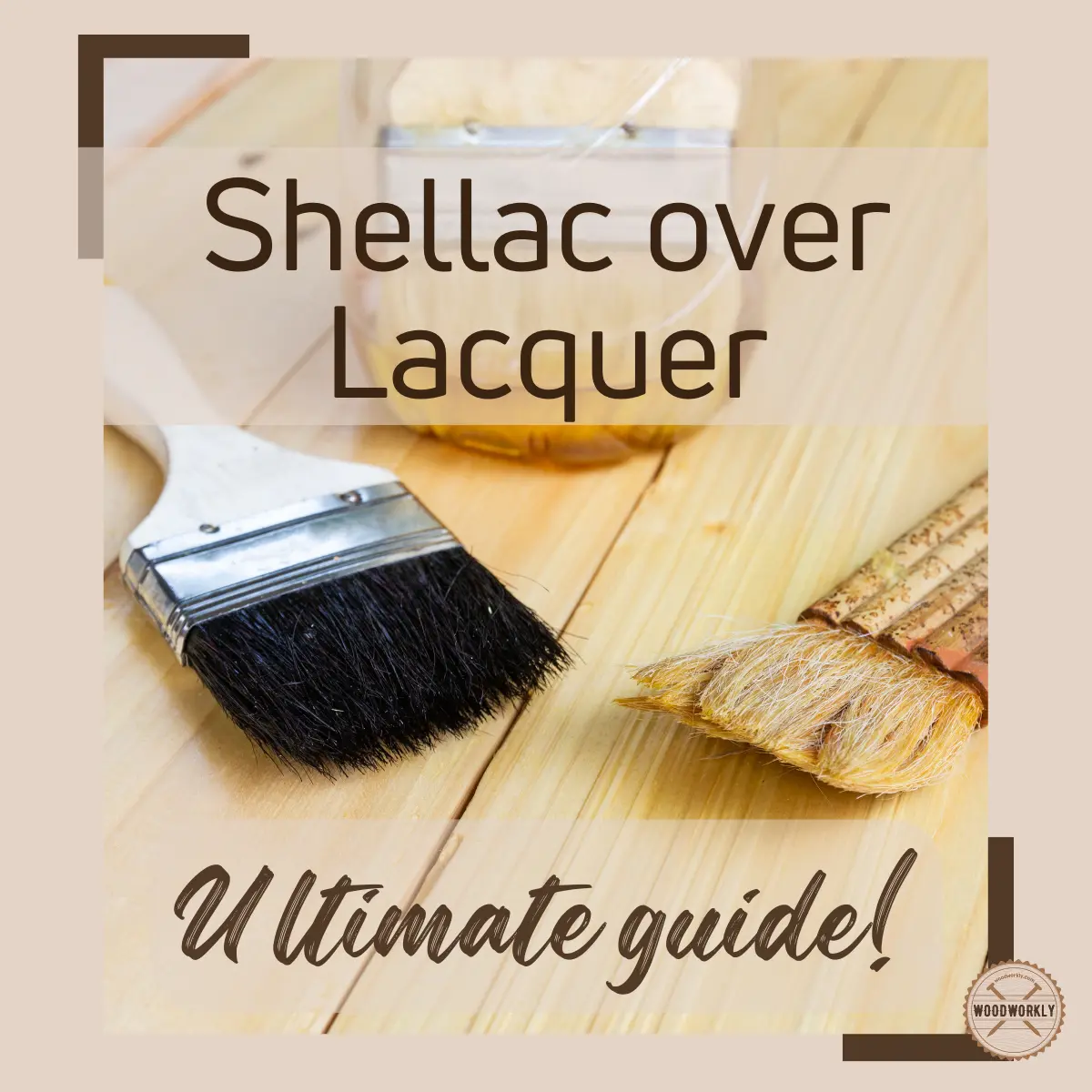
Have you ever thought about putting shellac on top of lacquer? I tried it once. I coated my wooden desk with lacquer, hoping it would look really nice.
But it didn’t turn out the way I wanted.
I was scared to remove the lacquer because I didn’t want to ruin the wood. So, I wondered if I could just put shellac on top of it.
I looked up some information and asked experts if it was okay to put these two things together.
Here’s what I found out.
Let’s discuss, Can you shellac over lacquer?
Yes, you can apply shellac over lacquer with proper preparation. Lightly sand the lacquered surface for better adhesion, clean it, and then apply a thin coat of shellac. Ensure the lacquer is fully dry before applying shellac to avoid adhesion issues.
Better if you apply lacquer over shellac since it adheres well with shellac and provides a nice finish.
But when you don’t have any other option, yes, applying shellac over lacquer is possible.

In this article, I’ll discuss whether can you put shellac over lacquer and how it should be done properly.
Furthermore, I’ll answer some frequently asked questions.
Let’s jump in!
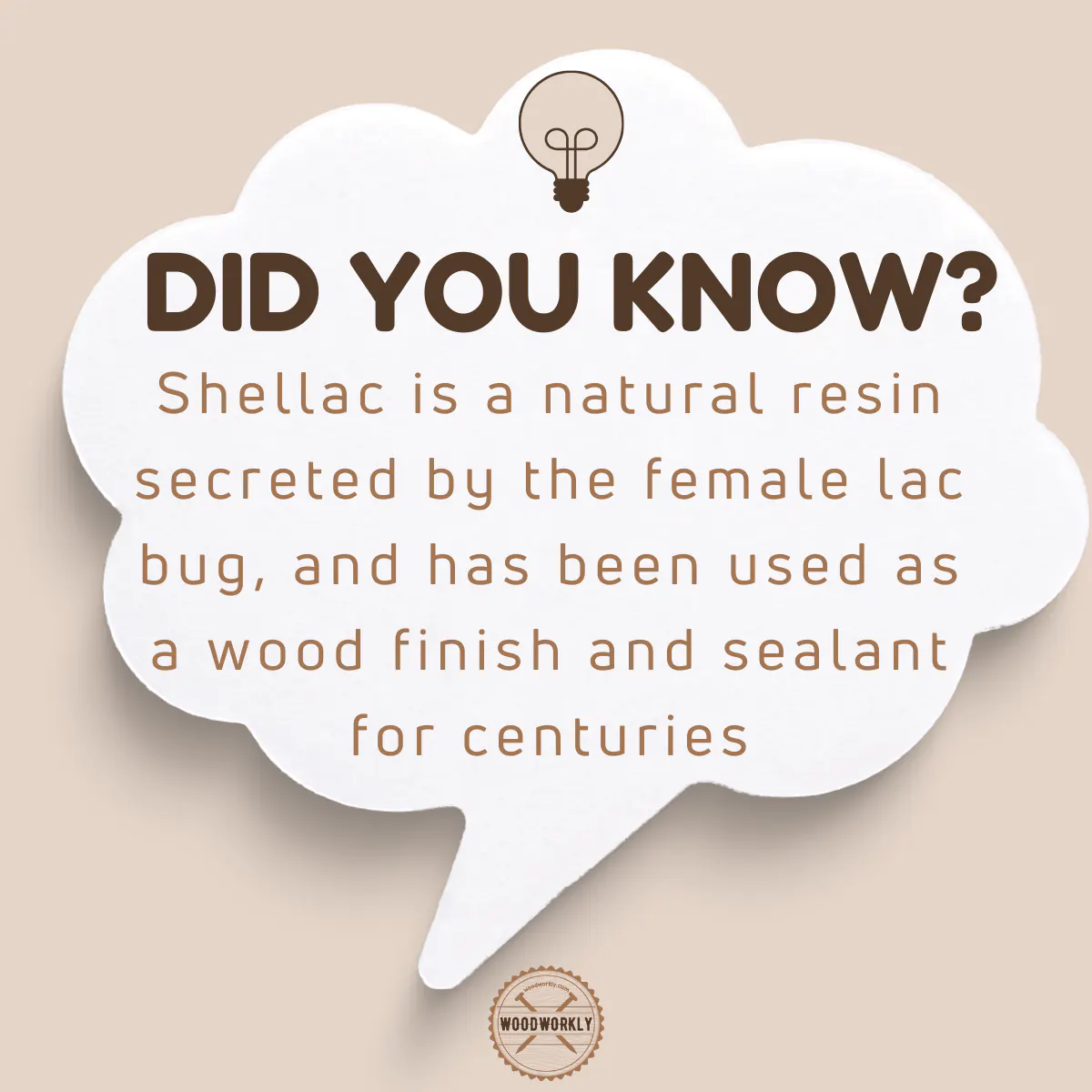
Can I Put Shellac Over Lacquer?
Yes, you can put shellac over lacquer. but generally, lacquer is harder and more durable than shellac. Therefore, applying shellac over lacquer is like putting a softer finish over a harder one.
Better if you can apply lacquer over shellac since lacquer seal and finish wood better than shellac. But this can vary on personal preference.
The issue is lacquer makes it harder to coat over the wood surface by coving the whole wood surface evenly including wood pores.
Usually, wood finishes bond with wood by penetrating those pores in the wood. Since lacquer already covered and sealed the wood pores, shellac won’t get the opportunity to get into wood pores.
This prevents shellac from adhering well to the wood which can lead to layer separation between lacquer and shellac.
In order to prevent or minimize that you should lightly sand the lacquer layer well before applying shellac over it.
Sanding helps to smoothen the lacquer layer and improve its adhesion. Having good adhesion on the lacquer layer makes shellac easy to adhere well onto the surface.
Applying shellac directly over lacquer with no sanding prior to lead shellac to peel off and bubbling up.
This will ruin the wood’s appearance and break the wood’s protection against environmental elements.
Apart from light sanding, you should also apply a thin coat of shellac since mixing two different types of wood finishes make the coats thicker and cause slow drying time.
Tip:
- According to the experts, applying shellac over lacquer is only recommended when you accidentally applied lacquer first over wood and if you really want to use shellac over it.
- Otherwise, apply shellac first as a finishing primer which helps to pop up the grain attractively, and then the lacquer goes on top.
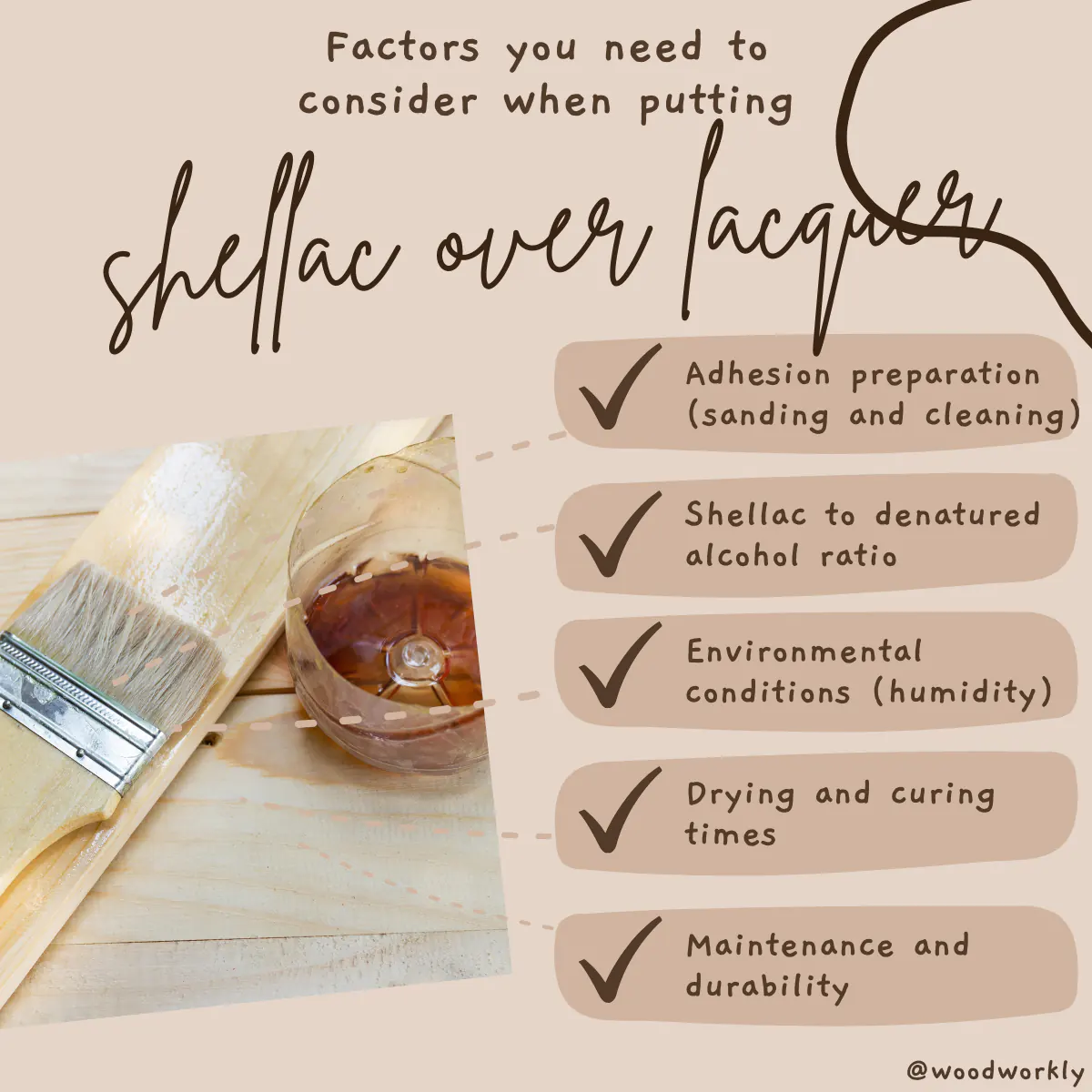
Problems That May Occur When Applying Shellac Over Lacquer
1. Shellac leads to peeling off or bubble up
This happens due to the surface separation between lacquer and shellac. Lacquer cover and seal wood pores and shellac won’t be able to contact with wood pores to adhere well onto the surface.
You can prevent shellac from peeling off or bubbling up by light sanding lacquer before shellac.
2. Streaking and wrinkling on lacquer finish
This happens because shellac dries slower than the lacquer finish. When you apply shellac over lacquer, the project takes longer time to dry and cure.
This makes moisture sit more time on the surface which leads to wrinkling and streaking on the lacquer finish. This may lead to a blotchy surface.
You can prevent wrinkling and streaking on the lacquer finish by applying a thin coat of shellac which helps it to dry quicker and minimize the drying time gap between lacquer and shellac.
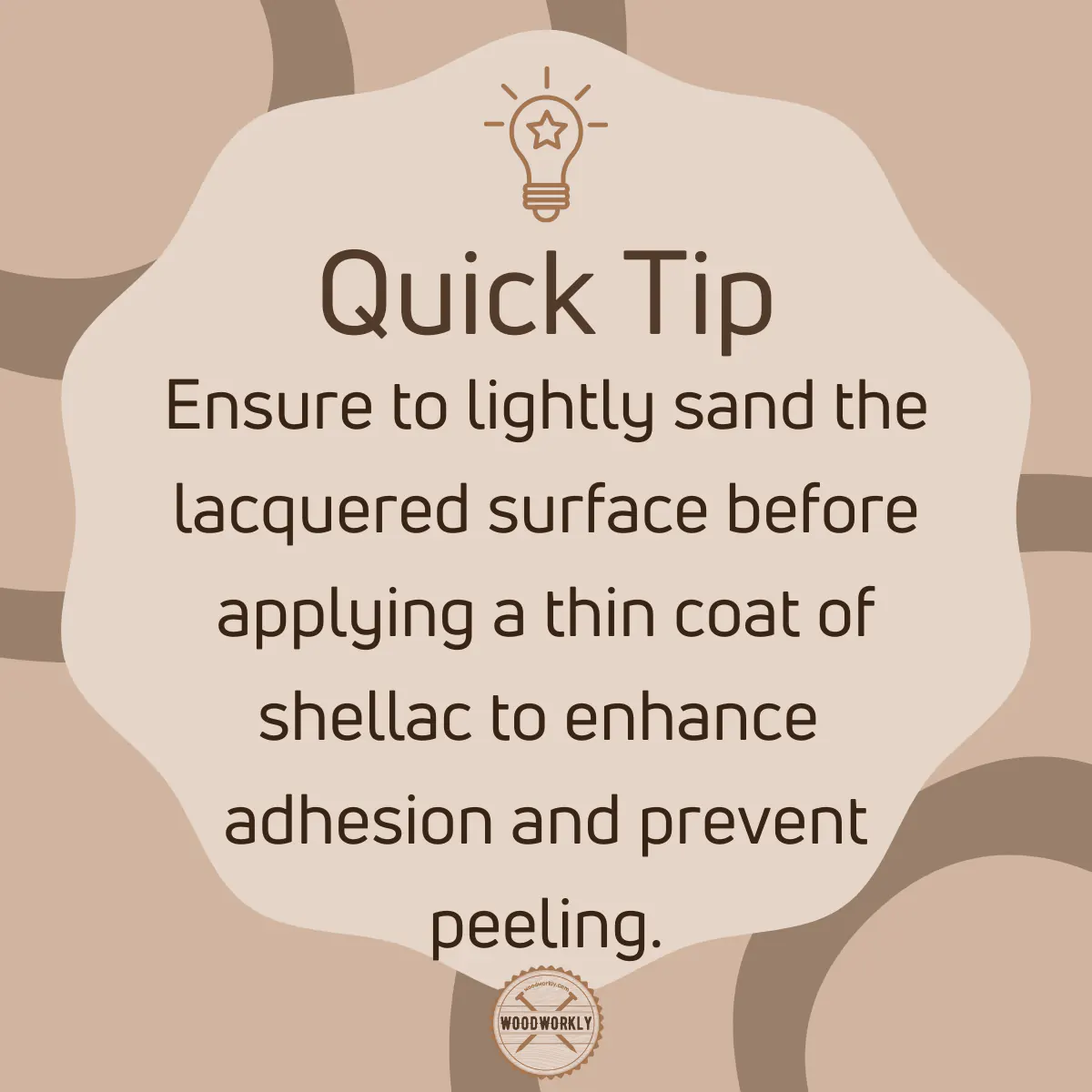
3. Need High maintenance
Shellac is a less durable and brittle finish than lacquer. Even though it provides a nice-looking and protective finish, you should maintain, clean, and reapply it more often than a lacquer finish.
Poor maintenance and exposure to alcohol and high moisture can lead shellac finish prone to chipping and flaking and damage the wood. plus, it is susceptible to scratches.
When cleaning, reapplying, and maintaining the shellac layer placed over the lacquer, you should be careful not to damage the lacquer layer underneath.
Otherwise, you’ll have to repair the lacquer finish too which takes a lot of time and money.
That’s it.
Because of the above reasons people tend not to apply shellac over lacquer but the other way around.
Applying lacquer over shellac gives a nice protective and more durable finish that dries quickly with less issues.
Plus, applying lacquer over shellac is fun and easy and you have fewer things to worry about.
But applying shellac over lacquer is also possible if you do it with a good focus minimizing all the mistakes that could happen.
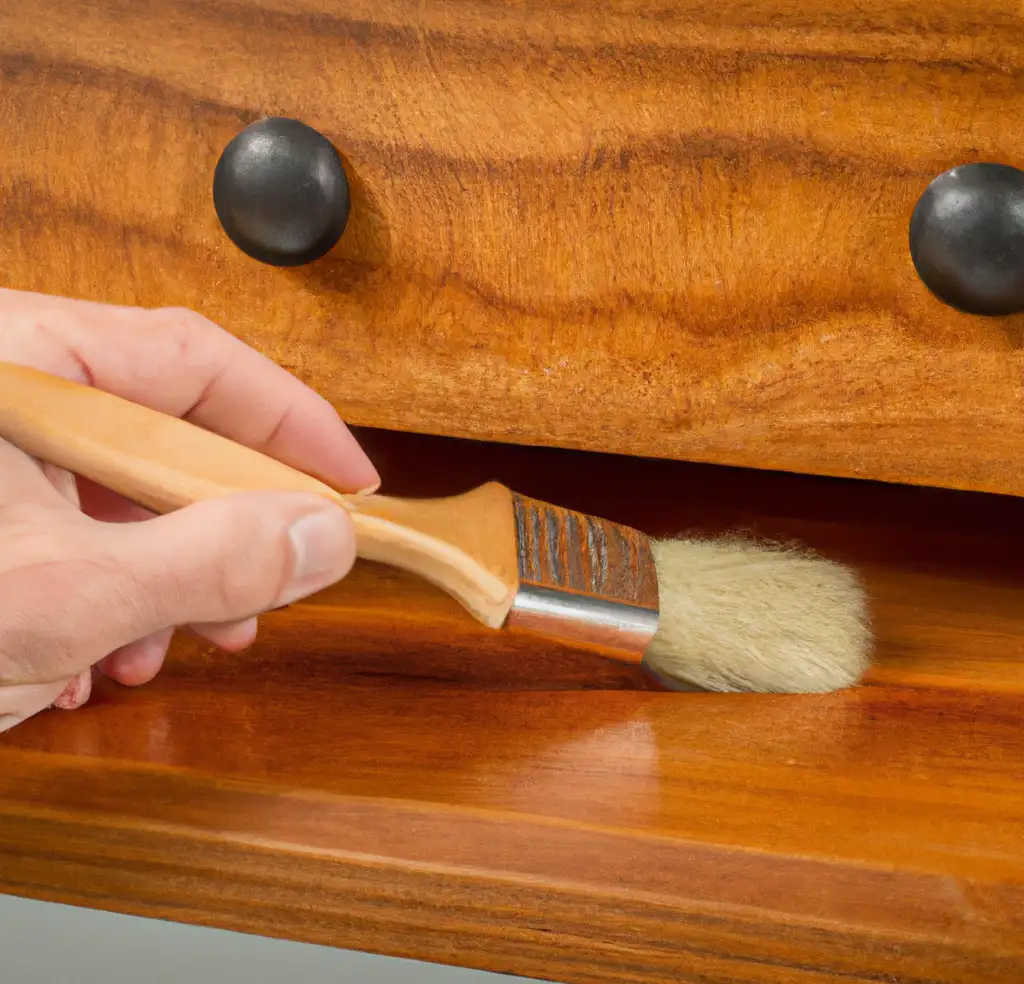
Let’s discuss how to do that properly! Challenging but possible!
Best Shellac to Put Over Lacquer
Before starting the project, you need to select the best shellac product that can be put over lacquer to minimize all the issues that could happen.
Zinsser Bulls Eye Shellac is the best product to put over lacquer. Apply thin coats of shellac properly using the correct method.
Here’re some variations of shellac that can be used to put over lacquer,
- White shellac for light woods with light color lacquer finish on top
- Orange shellac for amber color woods with amber color lacquer finish on top
Check out, How To Apply Bulls Eye Shellac in 7 EASY Steps!
Tip:
- Better not to use handmade shellac when applying shellac over lacquer since high purity is a must and we’re already taking a challenge by applying shellac over lacquer finish which seems impossible.
- Purchase shellac products from a quality brand.
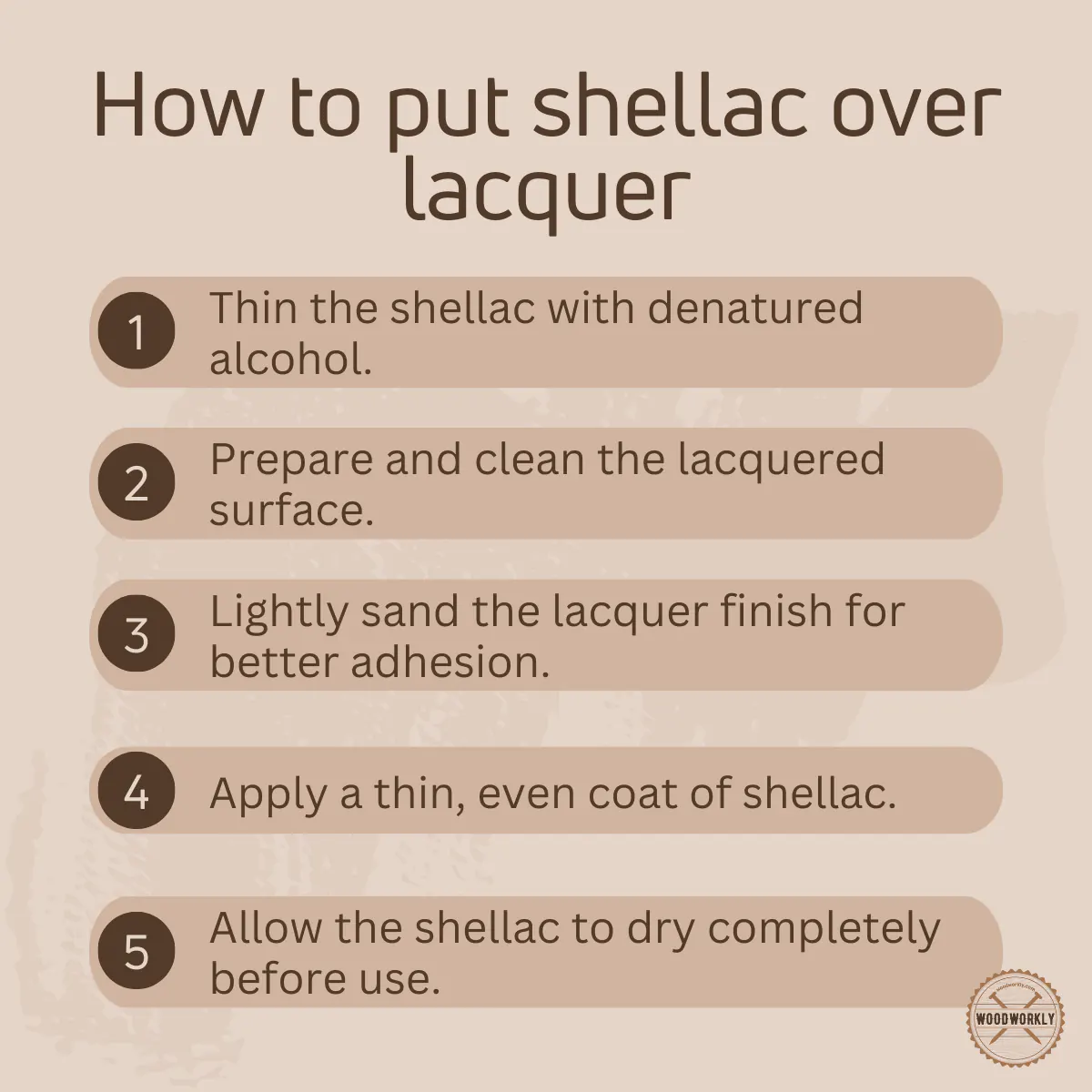
Tools And Materials To Apply Shellac Over Lacquer
- Shellac
- Fine bristle brush
- Clean glass jar
- Lint-free tack cloth
- Denatured alcohol
- 400 grit or finer grit sandpaper
- Rags
- Measuring cup
- Wood coated with lacquer finish
Gather all the materials required and start to apply shellac over lacquer properly.
How To Apply Shellac Over Lacquer?
Here’re the steps you need to follow when applying shellac over lacquer,
- Thin shellac
- Surface Preparation
- Light sand the lacquer finish
- Apply shellac
- Let it dry completely
So, let’s discuss each of the above steps in detail to apply shellac over lacquer without any issues.
1. Thin Shellac
Before applying shellac directly on the lacquered wood surface, you should thin the shellac with denatured alcohol.
Thinning helps to make thin coats of shellac and thin coats of shellac dry and cured faster which is essential since we need to reduce the drying time to avoid streaks and blotches.
First, take the glass jar and pour a sufficient amount of shellac into it. Then pour denatured alcohol are stir the mixture slowly to thin out the shellac.
The mixing ratio of shellac to denatured alcohol should be 1:4 which means 1 part of shellac should thin out with 4 parts of denatured alcohol.
After thinning the shellac test, it was out on scrap wood. if you feel the shellac needs to be thinned more, add more denatured alcohol to the compound and stir well.
Finally, keep the thinned shellac mixture in a dust-free environment in a closed container until it applies to the project.
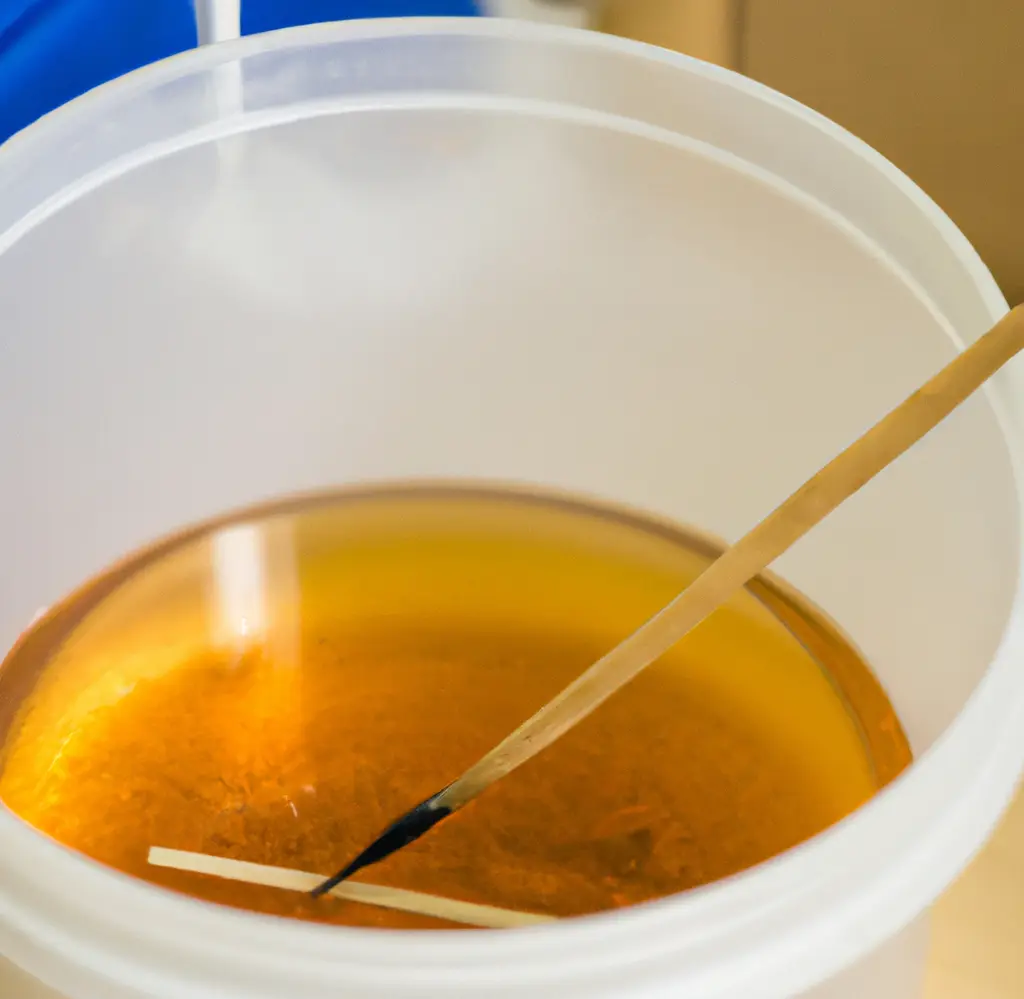
2. Surface Preparation
Take your lacquer-finished furniture or woodwork to a well-ventilated area before starting the project. Having good air circulation helps thin coats of shellac to dry faster.
Having a big drying time gap between lacquer and shellac gives trouble. Therefore, try to reduce it by letting the shellac layer dry faster.
Then, clean the whole lacquer-finished wood surface with clean rags to remove dust, debris, grease, and dirt.
Make sure not to use any chemicals to clean the surface since they can damage the lacquer finish.
3. Light Sand The Lacquer Finish
Light sanding the lacquer finish is a must before applying shellac over it. Light sanding helps to smoothen the lacquer finish and improve the adhesion between the lacquer and shellac layers.
Since the lacquer finish has already sealed and covered up wood pores, shellac needs to have a good adhesive surface to stick onto.
By making the lacquer surface more adhesive, shellac is able to attach well to the lacquer surface without surface separation or peeling off.
Take a fine 400 grit or finer sandpaper and buff the lacquer surface without damaging the finish. We just need to give adhesive properties to the lacquer finish. Not to damage or scratch with sandpaper.
Sand the whole lacquer surface in one direction without missing any spots.
Once you’re done with sanding, wipe and clean the surface to remove dust or use a dust collection pipe.
Now your furniture that is already finished with lacquer is ready to take on shellac. Sanding improves the compatibility between lacquer and shellac.

4. Apply Shellac Over Lacquer
Now apply the prepared thinned shellac mixture on a lacquer finish using a clean cotton rag or bristle brush.
Apply a thin coat of shellac evenly all over the lacquer finish without missing any spot along the direction of the wood grain to adhere well onto the surface.
A thin coat of shellac sticks well onto the lacquer finish and dries faster without forming blotches and streaks.
Since the surface is already finished with lacquer, one coat of shellac is more than enough to cover and seal the wood.
Shellac provides a nice finish over lacquer providing good protection from environmental elements such as moisture, and insect attacks.
All the cracks and scratches are covered and fixed with the coat of shellac.
5. Let It Dry Completely
After applying a thin coat of shellac over lacquer finish let it dry for 30 to 50 minutes.
Even though shellac dries slower than lacquer, you can speed it up by opening windows and making the space more ventilated.
Drying time can vary on the humidity in the air and temperature levels. However, wait at least one hour until the shellac coat dries completely before using the project.
After that, you can apply wax if necessary to provide the surface with a nice look and feel when touching.
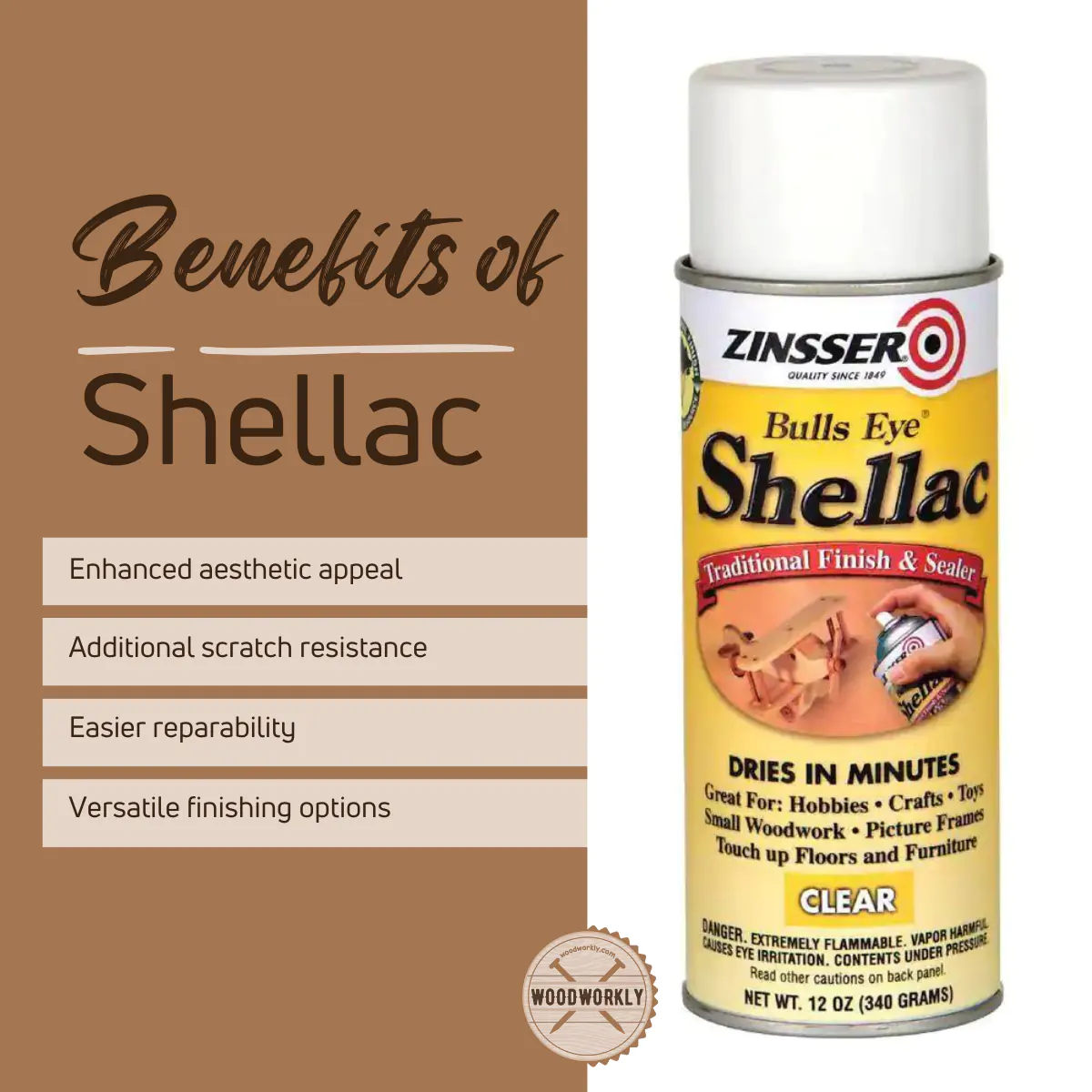
That’s it, folks! This is how you should apply shellac over lacquer perfectly without messing things up. It is not hard as you think!
Can You Seal Over Lacquer?
Yes, you can seal over lacquer. First light sand the lacquer finish to improve the adhesion between the lacquer and the sealer.
Apply a thin coat of sealer over the lacquer finish to dry faster and to keep the surface from blotches and streaks.
By sealing lacquer you’ll be able to protect the wood underneath from water damage, insect attacks, temperature variations, and a lot more.
But lacquer already seals the wood properly and there’s no use for sealing lacquer.
If you’re not satisfied with the lacquer finish, scrape the existing lacquer finish and apply a new one carefully without damaging the wood underneath.
How Long To Let Lacquer Dry Before Shellac?
Let the lacquer dry anywhere between two hours to four days before applying shellac. Drying time can vary on the environmental humidity and the thickness of the lacquer coat.
Never apply shellac before the existing lacquer coat dried completely.
Check the lacquer surface after 4 days and apply a thin coat of shellac over it in a well-ventilated area since shellac dries slower than lacquer and fast drying helps to avoid wrinkles on the lacquer finish.
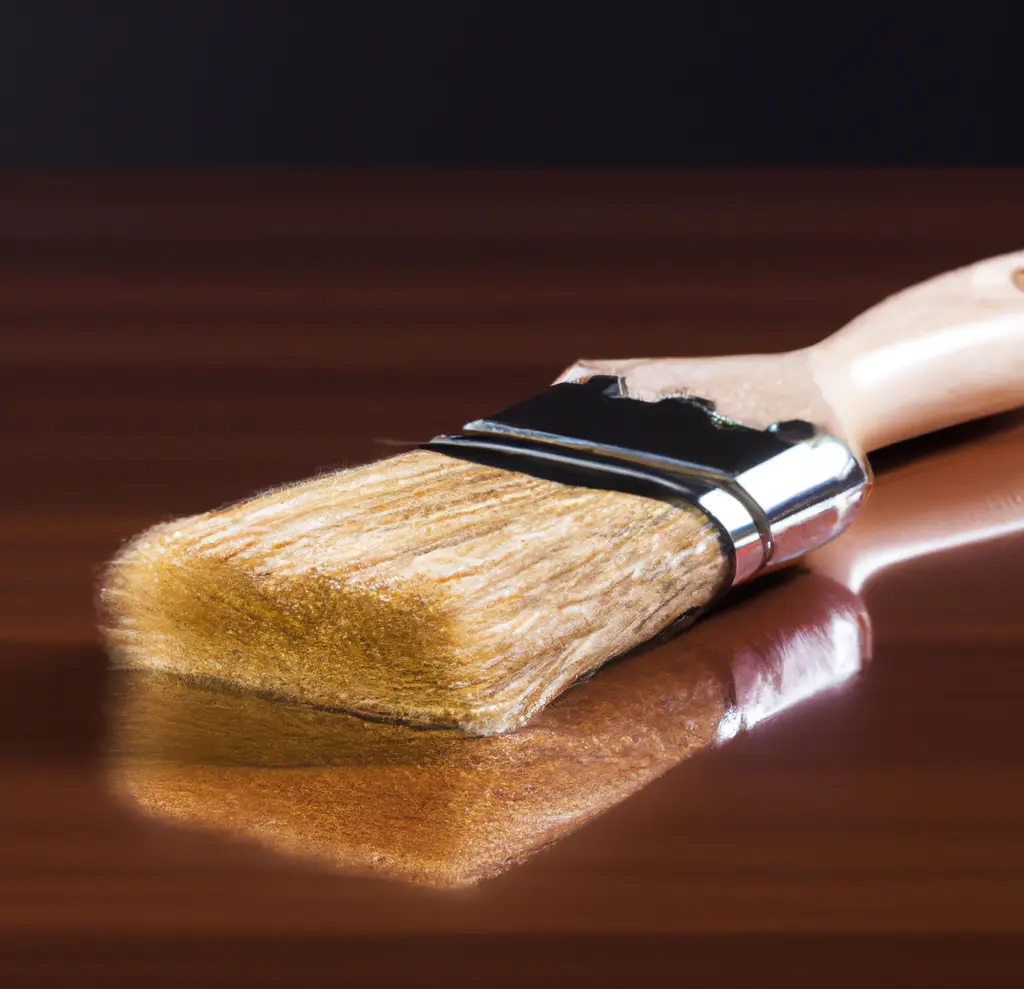
What Finish Can Be Applied Over Lacquer?
Here’re some finishes that can be applied over lacquer,
- Shellac
- Spar varnish
- Oil-based polyurethane
Make sure to apply the above finishes over the lacquer when the lacquer finish dried and cured properly after 4 days.
Never apply before the lacquer dries completely which leads to a tacky surface.
Apply thin coats of finish to dry fast and efferently and to get the finish as you wish.
Can You Put Lacquer Over Shellac?
Yes, you can put lacquer over shellac. Shellac is great as a finish primer and lacquer helps to seal the wood and protect it from weather elements.
Shellac provides a nice and smooth finish and helps to cover up and fix small cracks and gaps in the wood. plus, it can apply directly over bare wood and stick well by penetrating wood pores.
Here, shellac act as a sealer under the lacquer by fixing the wood imperfections and providing a good base layer for the lacquer to adhere well.
Using lacquer as a topcoat over shellac is better than applying shellac over lacquer since lacquer finish is harder and more durable than shellac.
The shellac-lacquer finish can last for years with no issues.
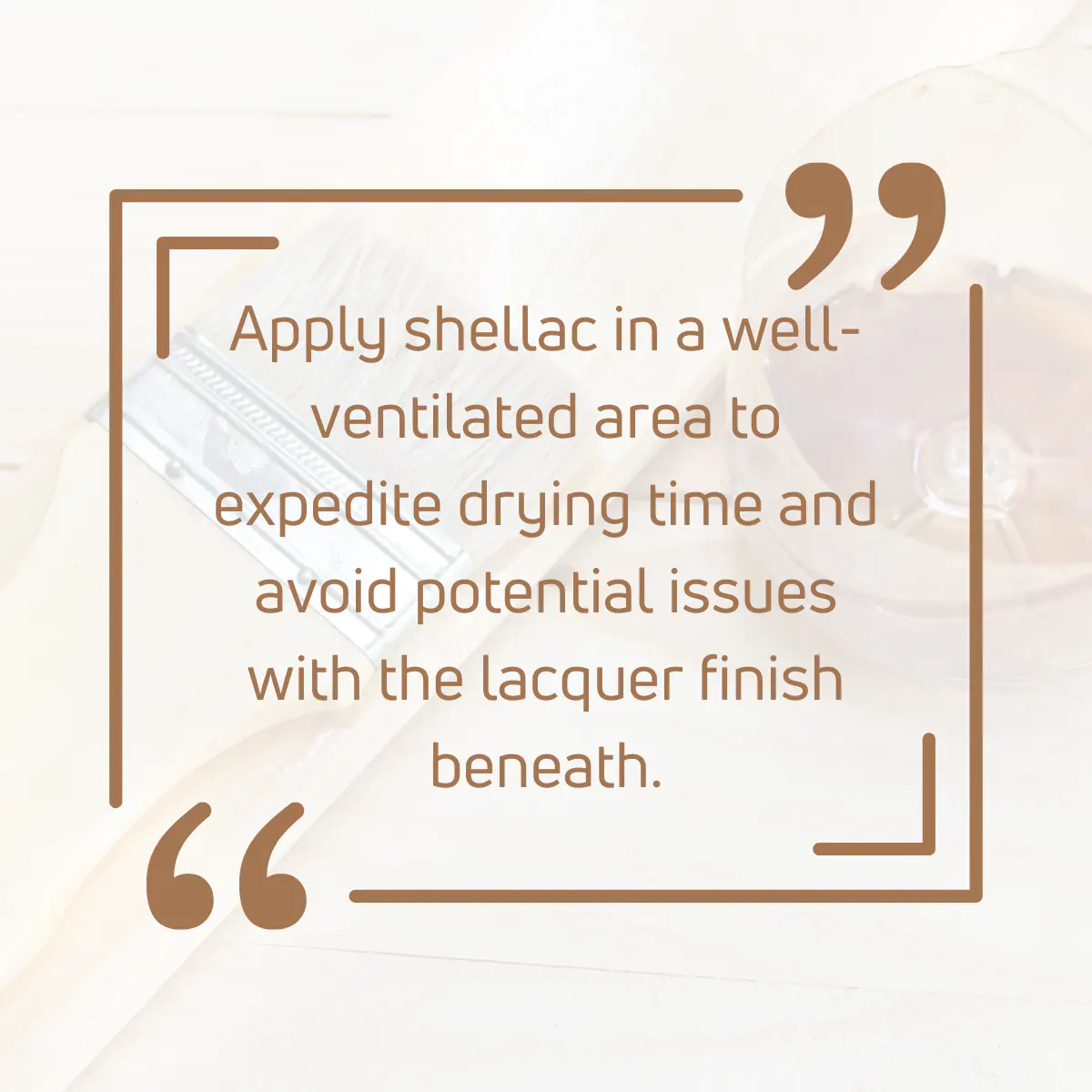
Let’s answer some frequently asked questions.
FAQs
What are the Challenges of Applying Shellac Over Lacquer?
Applying shellac over lacquer can lead to peeling, bubbling, and adhesion issues because lacquer seals wood pores, making it difficult for shellac to bond. Lightly sanding the lacquer surface can mitigate these issues.
Does Shellac Dry Faster Than Lacquer?
Shellac dries quickly, often being ready for a second coat in as little as 30 minutes. However, it’s not as durable as lacquer and can be sensitive to water, heat, and alcohol.
How Do You Prepare Lacquered Wood for Shellac Application?
Prepare lacquered wood for shellac application by lightly sanding the surface to improve adhesion. The wood should then be cleaned to remove dust and debris before applying a thin coat of shellac.
How Long Should Lacquer Dry Before Applying Shellac?
Lacquer should be allowed to dry for anywhere between two hours to four days before applying shellac, depending on the environmental humidity and the thickness of the lacquer coat. Shellac should only be applied once the lacquer is completely dry.
Is it Necessary to Seal Over Lacquer?
Sealing over lacquer is typically not necessary as lacquer itself acts as a sealant. However, if desired, a thin layer of sealer can be applied after lightly sanding the lacquer surface.
How Do You Repair Shellac Over Lacquer if Mistakes Occur?
If mistakes occur when applying shellac over lacquer, simply sand down the affected area and reapply the shellac. There’s no need to strip the entire piece of furniture to correct a small error.
What are the Pros and Cons of Using Shellac Over Lacquer?
While shellac is easy to repair and dries quickly, it’s not as durable as lacquer and can be sensitive to various elements. Lacquer, although more durable and moisture-resistant, can be difficult to apply evenly and may yellow over time.
What Type of Shellac is Best to Use Over Lacquer?
Zinsser Bulls Eye Shellac is often recommended for applying over lacquer. Ensure the lacquer surface is lightly sanded and cleaned before application to achieve the best results.
Did I cover all you wanted to know about: Can You Shellac Over Lacquer?
In this article, we deeply discussed applying shellac over lacquer with all the pros and cons. Using the method discussed above you’ll be able to apply shellac over lacquer with no issues.
You can apply shellac over lacquer finish but first, you should lightly sand the lacquer finish to improve the adhesion and apply a thin coat of shellac to dry faster. Applying lacquer over shellac is recommended since applying shellac over lacquer may lead to shellac bubbling up and peeling off.
Furthermore, I’ve answered some frequently asked questions as well.
Hope you learned everything you wanted to know about using shellac over lacquer finish.
Always try to apply shellac fist on bare wood and then go for lacquer for a better finish. But if you have no other option, Yes, you can apply shellac over lacquer but with good focus.